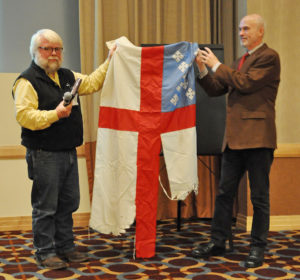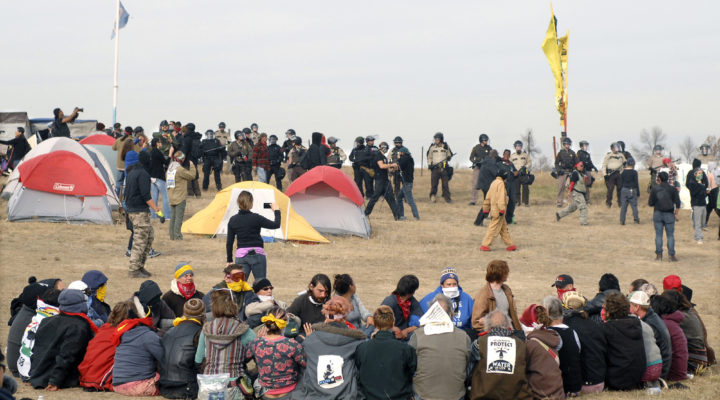More than 350 clergy from across the nation have said they will stand with the “water protectors” blocking construction of an oil pipeline adjacent to the Standing Rock Reservation in North Dakota during a “unified action” Nov. 3.
John Floberg, supervising priest of the Episcopal churches on the North Dakota side of Standing Rock, called for the clergy action, hoping for 100 positive responses.
Ellin Jimmerson, a Baptist minister in North Carolina and documentary producer with special interests in migration issues, is responding. She will be in Standing Rock for a required orientation Wednesday, prior to the unified clergy action Thursday, Nov. 3.

Ellin Jimmerson
She doesn’t know just what form the action will take, but organizers of the protest, which has gone on since April, emphasize a non-violent protest of presence, despite what Floberg calls “increasingly provocative and excessive” actions by authorities.
The protestors’ goal is to stop construction of a tar sands oil pipeline slated to cut through sacred burial grounds and under the Missouri River, where a break would threaten the water supply of everyone on the river, most immediately the indigenous tribes living nearby.
“Members of the clergy are often quite reluctant to take a stand,” said Jimmerson. “We saw in the civil rights movement that religious leaders were the last to arrive at the party. We need to be first.
“I’m not a hero by any stretch of the imagination. I don’t want to be arrested. I don’t want to be strip searched, which is happening even to journalists.”
Jimmerson produced “The Second Cooler,” a documentary on the thousands of deaths among those crossing into the U.S. through the barren Texas and Arizona deserts.
“What’s happening at Standing Rock is a much under-reported and exceptionally important event,” Jimmerson said. “This has to do with America’s long and sorry history of wanting to override indigenous people’s rights to their own lands.”
The pipeline will not go through reservation land, but runs perilously close to them, and earthmovers already have disrupted sacred grounds.
She is concerned that authorities view “water as a commodity to be exploited” and not a basic human right.
She sees the blatant disregard for indigenous people’s rights as a part of the “erasure of Native Americans from history books.” It continues a pattern of racist attitudes toward Native Americans, who have seen every treaty signed with U.S. government broken in some measure. More Native Americans are killed by police, per capita, than any other group, she said.

John Floberg (left) recently presented the Episcopal Church flag which has flown over the camp of water protectors at Standing Rock to the church’s archivist, Mark Duffy. It was the only Christian church flag flying at the camp. (Mary Frances Schjonberg/Episcopal News Service)
Susan Phillips, pastor of Shawano Presbyterian Church in Shawano, Wisc., said another indication of the racism prevalent in the pipeline’s route is that originally it was slated to go much closer to Bismarck, N.D. When residents there resisted, it was rerouted toward the reservation.
Ignoring Army Corps of Engineers request to stay 20 miles back from the contested sites, Dakota Access has powered through 17 miles of that zone, according to Philips, whose town is surrounded by reservations.
Her church is seven miles from the Menominee Nation; her house is four miles from the Mohican Nation with Ho-Chunk and Oneida tribes to either side.
Phillips and her husband and children accompanied friends who are enrolled members of the Menominee Nation to Standing Rock Oct. 19-22.
Phillips visited three of the four camps set up around the disputed area and brought greetings as a member of the Winnebago Presbytery and the Synod of Lakes and Prairies, whose executive is an enrolled tribal member of the Delaware.
The “water protectors” are very organized and no one is to participate in direct action at the point of confrontation unless they have completed training.
“It is important that people are well prepared about what to expect and how to engage in peaceful, prayerful presence,” she said.
Participants in the unified action will be trained before the protests in “how to walk up to the line and not cross it,” according to Floberg’s letter to clergy.
This summer youths in the camps began running for activity, and then training. They ran to various area agencies to give visibility to their protest. Eventually a number of them ran 1,800 miles from Standing Rock to Washington, D.C., to present thousands of signatures on petitions to the Army Corps of Engineers to stop the pipeline.
Over Labor Day weekend the tribe petitioned the court for an injunction to prohibit construction. The day after the court said it would consider the request, Dakota Access brought its equipment from miles away “and plowed through” some of those sacred locations the petition would have protected, Phillips said.
It was at that point the “water protectors” crossed the fence to stop the construction activity and pipeline building Dakota Access sicced dogs on them.
With winter coming the local Episcopalian church is offering adjacent land to set up a winter camp, with church facilities available as a community center. Floberg has been involved in ministry in the area for 25 years and he is thrilled at the response to his letter requesting that clergy join him in a unified action.
“I just hope to be a part of a clergy presence there that says violating indigenous people’s sovereign rights to determine what happens on their own land is contrary to God’s will,” Jimmerson said. “Neither people nor the land are commodities to be exploited.”
Related commentary:
Confrontation at the Cannonball: The Dakota Access Pipeline controversy


